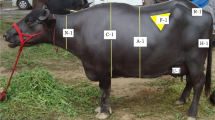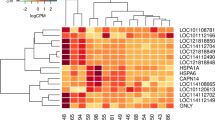Abstract
Cutaneous evaporation is the main avenue by which cattle dissipate heat via the involvement of sweat glands and other skin components. The difference in skin morphology between B. indicus and B. taurus has been recognized, as well as differences in their ability to tolerate heat. The objective of this study was to compare skin morphology between B. indicus, B. taurus, and their crossbreds. Skin samples of Sahiwal (B. indicus) (n = 10, reddish brown skin) and Holstein Friesian (HF) (B. taurus) (n = 10, black and white skin) and crossbred of HF75% (n = 10, black and white skin) and HF87.5 % (n = 10, black and white skin) were biopsied for histological study, followed by measurement of skin components. The results indicated that breed significantly affected sweat gland morphology. The shape of the sweat gland, as indicated by the ratio of length/diameter, in Sahiwal was baggier in shape compared to HF (5.99 and 9.52) while values for crossbreds were intermediate (7.82, 8.45). The density and volume of sweat glands in Sahiwal (1,058 glands/cm2; 1.60 μ3 × 10−6) were higher than in HF (920 glands/cm2; 0.51 μ3x10−6) and crossbreds, both HF 75 % (709 glands/cm2; 0.68 μ3 × 10−6) and HF 87.5 % (691 glands/cm2; 0.61 μ3 × 10−6) respectively. However, capillary surface area was greater for HF (2.07 cm2) compared to Sahiwal (1.79 cm2); accordingly, the lower genetic fraction of HF in crossbred cattle showed less capillary surface area (1.83 and 1.9 cm2 for HF75% and HF87.5 %) (P < 0.01). Nerve density was not significantly different between Sahiwal and HF but was higher in the crossbred (P < 0.01) cattle. Moreover, the effect of skin color (black and white) was evaluated and it was found that there was an interaction (P < 0.01) between breed and skin color on the skin components. This study reveals that there are differences in skin morphology among B. indicus, B. taurus and their crossbreds, with these differences being more or less related to the genetic fraction of HF. This may imply that capability for cutaneous evaporative heat loss and tolerance to heat in crossbred cattle could be related to skin morphology.




Similar content being viewed by others
References
Allen TE (1962) Responses of Zebu, Jersey, and Zebu X Jersey crossbred heifers to rising temperature, with particular reference to sweating. Aust J Agric Res 13:165–179
Allen TE, Pan YS, Hayman R (1963) The effect of feeding on the evaporative heat loss and body temperaturein Zebu and Jersey heifers. Aust J Agric Res 14:580–593
Beatty DT, Barnes A, Taylor E, Pethick D, McCarthy M, Maloney SK (2006) Physiological responses of B. taurus and B. indicus cattle to prolonged, continuous heat and humidity. J Anim Sci 84:972–985
Becerril CM, Wilcox CJ (1992) Determination of percentage of white coat color from registry certificates in Holsteins. J Dairy Sci 75:3582–3586
Becerril CM, Wilcox CJ, Lawlor TJ, Wiggans GR, Webb DW (1993) Effects of percentage of white coat color on Holstein production and reproduction in a subtropical. J Dairy Sci 76:2286–2291
Carvalho FA, Lammoglia MA, Simoes MJ, Randel RD (1995) Breed affects thermoregulation and epithelial morphology in imported and native cattle subjected to heat stress. J Anim Sci 73:3570–3573
Cunningham EP, Syrstad O (1987) Crossbreeding Bos indicus and Bos taurus for milk production in the Tropics. FAO Animal Production and Health Paper 68. FAO (Food and Agriculture Organization of the United Nations), Rome, Italy
Cunningham JG (2002) Textbook of veterinary physiology, 3rd edn. Saunders, Philadelphia
Dowling DF (1955) The hair follicle and apocrine gland population of Zebu (Bos indicus) and Shorthorn (B taurus) cattle skin. Aust J Agric Res 64:645–654
Finch VA (1986) Body temperature in beef cattle: its control and relevance to production in the tropics. J Anim Sci 62:531–542
Findlay JD, Yang SH (1948) Capillary distribution in cow skin. Nature 161:1012–1013
Findlay JD, Yang SH (1950) The sweat glands of Ayrshire cattle. J Agric Sci 40:126–133
Findlay JD, Robertshaw D (1965) The role of the sympatho-adrenal system in the control of sweating in the ox (B. taurus). J Physiol 179:285–297
Hahn GL (1999) Dynamic responses of cattle to thermal heat loads. J Anim Sci 77:10–20
Hales JR, Fawcett AA, Bennett JW, Needham AD (1978) Thermal control of blood flow through capillaries and arteriovenous anastomoses in skin of sheep. Pflug Arch 378:55–63
Jenkinson DM, Sengupta BP, Blackburn PS (1966) The distribution of nerves, monoamine oxidase and cholinesterase in the skin of cattle. J Anat 100:593–613
Jenkinson DM, Montgomery I, Elder HY (1978) Studies on the nature of the peripheral sudomotor control mechanism. J Anat 125:625–639
Jenkinson DM, Nay T (1968) Sweat gland and hair follicle measurements as indicators of skin type in cattle. Aust J Biol Sci 21:1001–1011
Jenkinson DM, Nay T (1975) The sweat glands and hair follicles of different species of bovidae. Aust J Biol Sci 28(1):55–68
Johnson KG, Hales JRS (1983) The microcirculation and sweating in isolated perfused horse and ox skin. J Therm Biol 8(3):273–277
Kadzere CT, Murphy MR, Silanikove N, Maltz E (2002) Heat stress in lactating dairy cows: a review. Livest Prod Sci 77:59–91
Klangchamnan P (2010) Relationship of cutaneous nerves and sweat gland on the black and white skin areas of Holstein Friesian crossbred heifers. Master thesis. Animal Science Department, Faculty of Agriculture, Kasetsart University, Thailand
McDowell RE (1972) Determining the suitability of livestock production in warm climates. In: McDowell RE (ed) Improvement of Livestock in warm climates. Freeman, San Francisco, pp 133–155
Nay T, Hayman RH (1956) Sweat Glands in Zebu (B. indicus L.) and European (B. taurus L) Cattle. I Size of individual glands. The denseness of their population, and their depth below the skin surface. Aust J Agric Res 7:482–495
Pan YS (1963) Quantitative and morphological variation of sweat glands, skin thickness and skin shrinkage over various body regions of Sahiwal zebu and Jersey cattle. Aust J Agric Res 14:424–437
Prasanpanich S, Hinch GN, Thwaites CJ, Baille ND, Vajrabukka C (2002) Skin temperature and sweating rate responses on the black and white skin areas of Friesian bull calves. Anim Prod Aust 24:181–184
SAS (1988) SAS/STATTM. Guide for personal computers version, 6th edn. SAS Institute, Cary
Schleger AV, Turner HG (1965) Sweating rate of cattle in the field and their reaction to diurnal and seasonal changes. Aust J Agric Res 16:92–106
Schleger AV, Bean KG (1971) Factors determining sweating competence of cattle skin. Aust J Biol Sci 24:1291–1300
Scharf B (2008) Comparison of thermoregulatory mechanisms in heat sensitive and tolerant breed of Bos taurus cattle. Master thesis department of animal science. Missouri University, Columbia, MO
Tadesse M, Dessie T (2003) Milk production performance of Zebu, Holstein Friesian and their crosses in Ethiopia. Livest Res Rur Dev 15(3). Retrieved 29 March 2013, from http://www.lrrd.org/lrrd15/3/Tade153.htm
Taneja GC (1959) Sweating in cattle. II. Cutaneous evaporative loss measured from limited areas and its relationship with skin, rectal, and air temperatures. J Agric Sci Camb 52(1):50–61
Turner HG, Schleger AV (1960) The significance of coat type in cattle. Aust J Agric Res 11:645–663
Udo HMJ (1978) Hair coat characteristics in Friesian Heifers in the Netherlands and Kenya. Master thesis. Agricultural University, Wageningen, The Netherlands
Yousef MK (1985) Stress physiology in livestock: Volume i basic principles. CRC, Boca Raton
Acknowledgments
This work received financial support from the Scholarship for Our Neighboring Countries Personnel Development, Khon Kaen University, and Heat-tolerance Dairy Cattle Research Group, Khon Kaen University. The experimental animals were kindly supported by Chiang Mai Livestock Research Station, Lumphayaklang Livestock Research Station, and Pakchong Livestock Research Stations. Facilities and technical support in the histological study was kindly provided by the Department of Anatomy, Faculty of Veterinary School, Khon Kaen University. The assistance of Ms. S. Suklerd, Mr. P. Pongthaisong and Animal Science postgraduate students are gratefully acknowledged.
Ethical Standard
The experimental procedure was approved by the Animal Ethics Committee of Khon Kaen University, based on the Ethics of Animal Experimentation of National Research Council of Thailand, No. AEKKU 62/2554.
Author information
Authors and Affiliations
Corresponding author
Rights and permissions
About this article
Cite this article
Jian, W., Duangjinda, M., Vajrabukka, C. et al. Differences of skin morphology in Bos indicus, Bos taurus, and their crossbreds. Int J Biometeorol 58, 1087–1094 (2014). https://doi.org/10.1007/s00484-013-0700-9
Received:
Revised:
Accepted:
Published:
Issue Date:
DOI: https://doi.org/10.1007/s00484-013-0700-9




